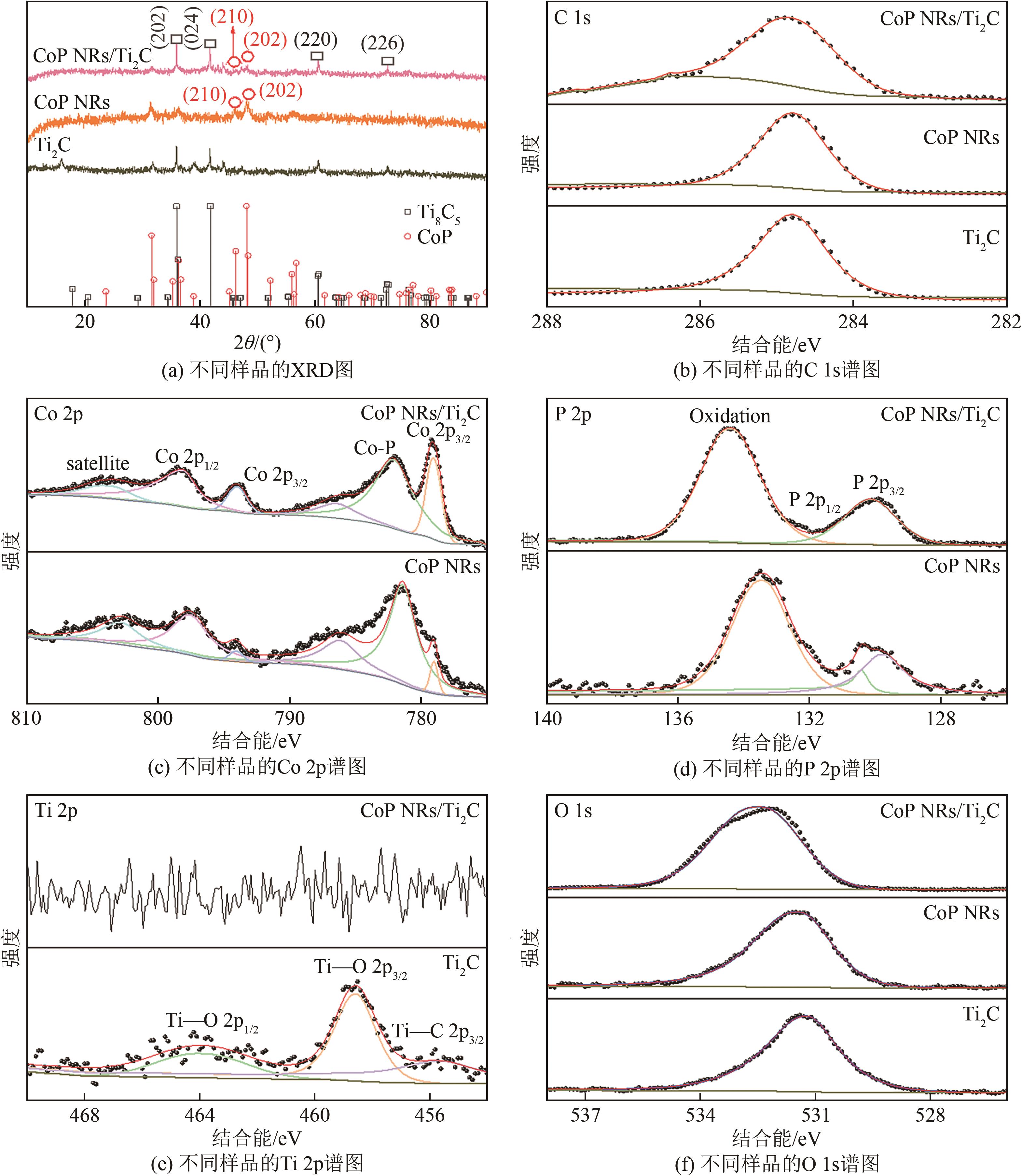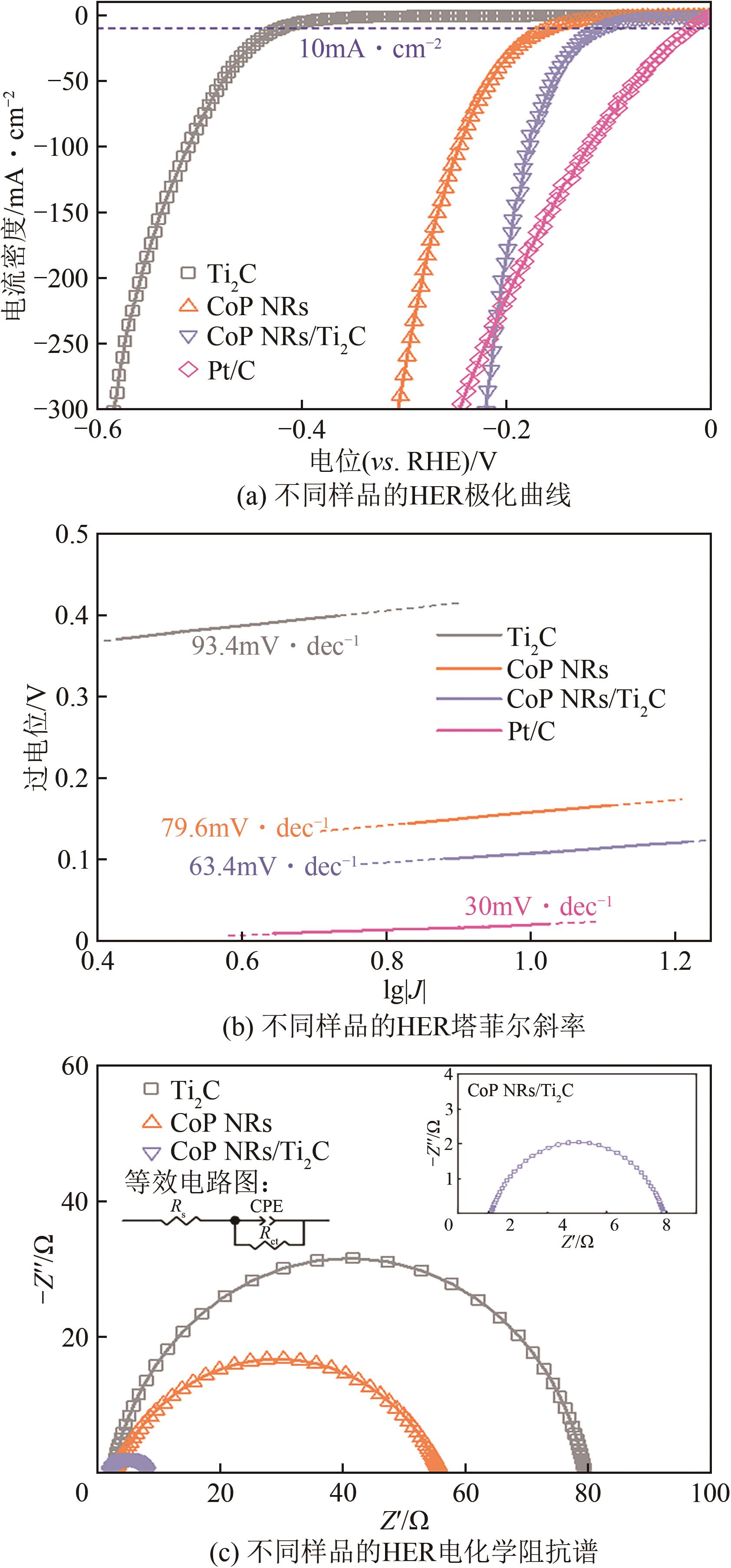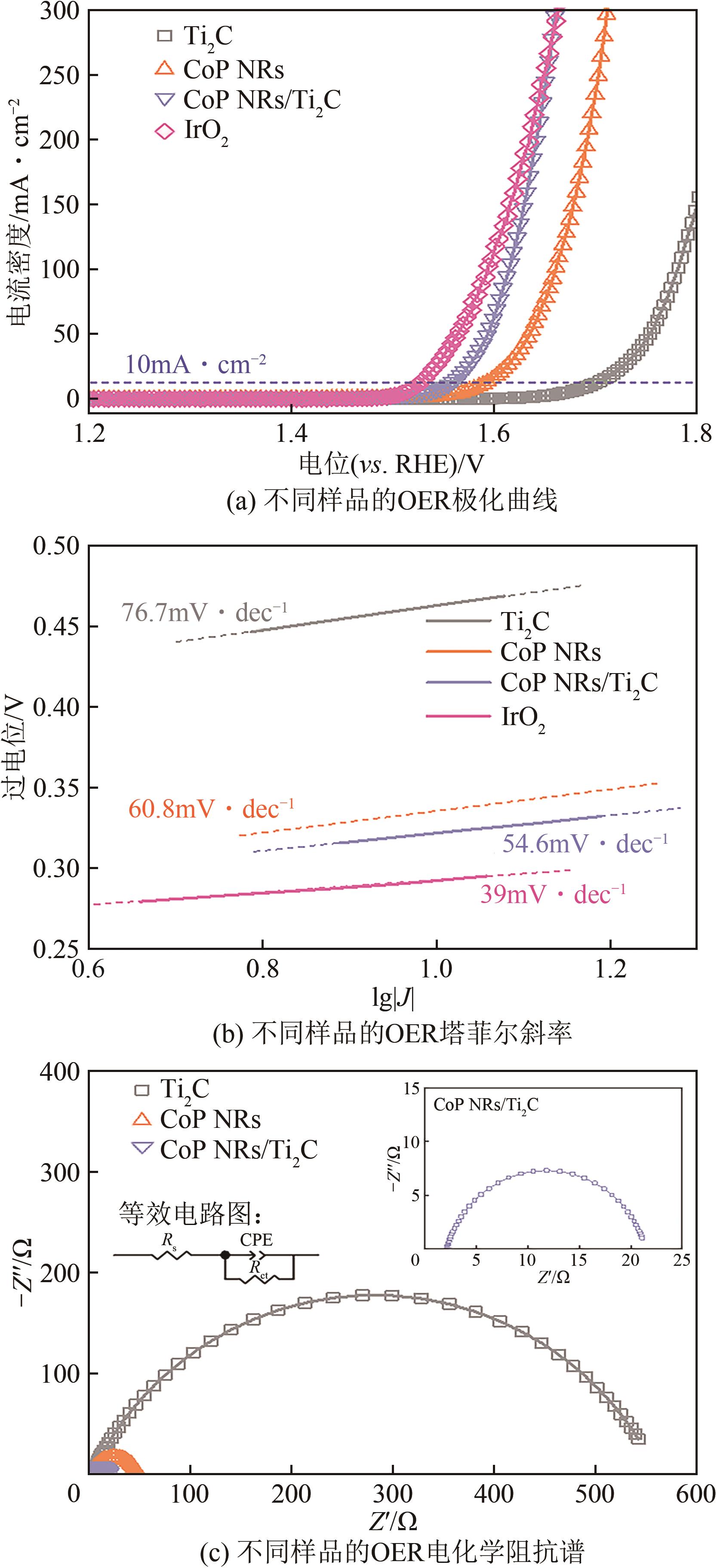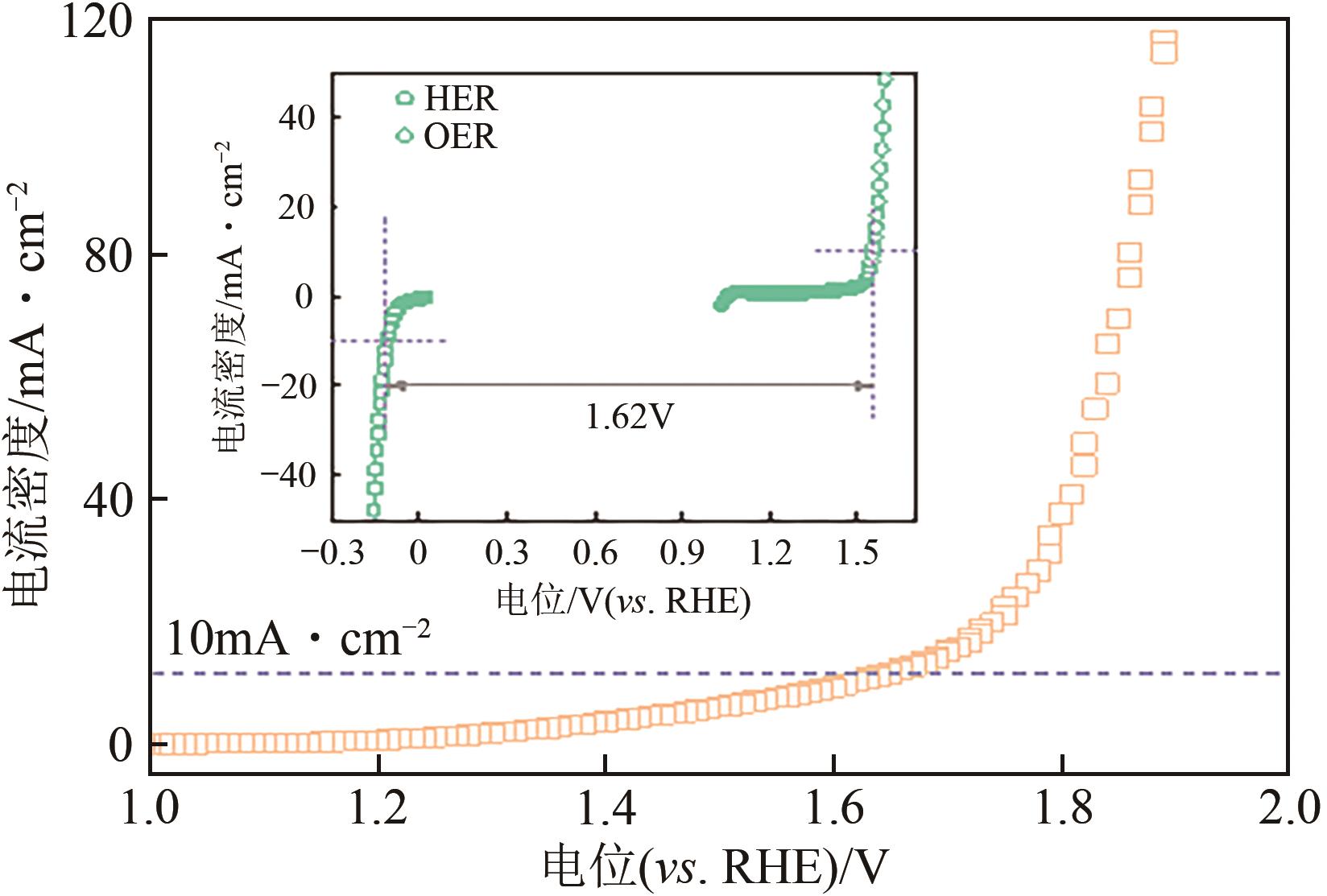Chemical Industry and Engineering Progress ›› 2024, Vol. 43 ›› Issue (6): 3232-3239.DOI: 10.16085/j.issn.1000-6613.2023-0789
• Materials science and technology • Previous Articles
Highly efficient electrocatalytic water splitting by MXene supported CoP nanorods
WAN Chengfeng1( ), LI Zhida1, ZHANG Chunyue1, LU Lu1,2(
), LI Zhida1, ZHANG Chunyue1, LU Lu1,2( )
)
- 1.School of Civil and Environmental Engineering, Harbin Institute of Technology, Shenzhen 518055, Guangdong, China
2.State Key Laboratory of Urban Water Resources and Water Environment, Harbin Institute of Technology, Harbin 150090, Heilongjiang, China
-
Received:2023-05-11Revised:2023-09-06Online:2024-07-02Published:2024-06-15 -
Contact:LU Lu
MXene负载CoP纳米棒高效电催化分解水制氢
- 1.哈尔滨工业大学(深圳)土木与环境工程学院,广东 深圳 518055
2.哈尔滨工业大学城市水资源与水环境 国家重点实验室,黑龙江 哈尔滨 150090
-
通讯作者:路璐 -
作者简介:万成凤(1999—),女,硕士研究生,研究方向为电催化。E-mail:21s054047@stu.hit.edu.cn。 -
基金资助:国家自然科学基金面上项目(22176046);广东省自然科学基金面上项目(2022A1515012016);深圳市自然科学基金面上项目(JCYJ20210324124209025)
CLC Number:
Cite this article
WAN Chengfeng, LI Zhida, ZHANG Chunyue, LU Lu. Highly efficient electrocatalytic water splitting by MXene supported CoP nanorods[J]. Chemical Industry and Engineering Progress, 2024, 43(6): 3232-3239.
万成凤, 李志达, 张春月, 路璐. MXene负载CoP纳米棒高效电催化分解水制氢[J]. 化工进展, 2024, 43(6): 3232-3239.
share this article
Add to citation manager EndNote|Ris|BibTeX
URL: https://hgjz.cip.com.cn/EN/10.16085/j.issn.1000-6613.2023-0789
| 催化剂 | HER过电位/mV | OER过电位/mV | 电流密度/mA·cm-2 | 参考文献 |
|---|---|---|---|---|
| SCNO@N-CNF | 169 | 247 | 10 | [ |
| NiCoP@rGO | 297 | 340 | 20 | [ |
| NiWO4/TM | 101 | 322 | 10 | [ |
| SrTiFe0.9Pr0.1O6-δ | 278 | 182 | 10 | [ |
| La0.5Sr0.5CoO3-δ/MoSe2 | 200 | 370 | 10 | [ |
| NiFeP@N-CS | 186 | 216 | 10 | [ |
| CoP/NCNHP | 115 | 310 | 10 | [ |
| CoP2/RGO | 88 | 300 | 10 | [ |
| MS-CoP x -350 | 190 | 300 | 10 | [ |
| CoP NRs/Ti2C | 105 | 320 | 10 | 本研究 |
| 催化剂 | HER过电位/mV | OER过电位/mV | 电流密度/mA·cm-2 | 参考文献 |
|---|---|---|---|---|
| SCNO@N-CNF | 169 | 247 | 10 | [ |
| NiCoP@rGO | 297 | 340 | 20 | [ |
| NiWO4/TM | 101 | 322 | 10 | [ |
| SrTiFe0.9Pr0.1O6-δ | 278 | 182 | 10 | [ |
| La0.5Sr0.5CoO3-δ/MoSe2 | 200 | 370 | 10 | [ |
| NiFeP@N-CS | 186 | 216 | 10 | [ |
| CoP/NCNHP | 115 | 310 | 10 | [ |
| CoP2/RGO | 88 | 300 | 10 | [ |
| MS-CoP x -350 | 190 | 300 | 10 | [ |
| CoP NRs/Ti2C | 105 | 320 | 10 | 本研究 |
| 1 | BARRETO L, MAKIHIRA A, RIAHI K. The hydrogen economy in the 21st century: A sustainable development scenario[J]. International Journal of Hydrogen Energy, 2003, 28(3): 267-284. |
| 2 | DINCER Ibrahim. Environmental impacts of energy[J]. Energy Policy, 1999, 27(14): 845-854. |
| 3 | MIDILLI A, AY M, DINCER I, et al. On hydrogen and hydrogen energy strategies Ⅰ: Current status and needs[J]. Renewable and Sustainable Energy Reviews, 2005, 9(3): 255-271. |
| 4 | SAZALI Norazlianie. Emerging technologies by hydrogen: A review[J]. International Journal of Hydrogen Energy, 2020, 45(38): 18753-18771. |
| 5 | YU Xiaowen, ZHAO Jun, ZHENG Lirong, et al. Hydrogen evolution reaction in alkaline media: alpha- or beta-nickel hydroxide on the surface of platinum?[J]. ACS Energy Letters, 2018, 3(1): 237-244. |
| 6 | WANG Jing, LIAO Ting, WEI Zhongzhe, et al. Heteroatom-doping of non-noble metal-based catalysts for electrocatalytic hydrogen evolution: An electronic structure tuning strategy[J]. Small Methods, 2021, 5(4): e2000988. |
| 7 | SU Jinzhan, ZHOU Jinglan, WANG Lu, et al. Synthesis and application of transition metal phosphides as electrocatalyst for water splitting[J]. Science Bulletin, 2017, 62(9): 633-644. |
| 8 | WU Rui, XIAO Bing, GAO Qiang, et al. A Janus nickel cobalt phosphide catalyst for high-efficiency neutral-pH water splitting[J]. Angewandte Chemie International Edition, 2018, 57(47): 15445-15449. |
| 9 | CHEN Peirong, YE Jianshan, WANG Hui, et al. Recent progress of transition metal carbides/nitrides for electrocatalytic water splitting[J]. Journal of Alloys and Compounds, 2021, 883: 160833. |
| 10 | YU Yadong, ZHOU Jian, SUN Zhimei. 2D transition-metal carbides: Novel 2D transition-metal carbides: Ultrahigh performance electrocatalysts for overall water splitting and oxygen reduction[J]. Advanced Functional Materials, 2020, 30(47): 2070311. |
| 11 | HUANG Xiaokang, GONG Li, XU Hui, et al. Hierarchical iron-doped CoP heterostructures self-assembled on copper foam as a bifunctional electrocatalyst for efficient overall water splitting[J]. Journal of Colloid and Interface Science, 2020, 569: 140-149. |
| 12 | ZONG Quan, YANG Hui, WANG Qianqian, et al. Three-dimensional coral-like NiCoP@C@Ni(OH)2 core-shell nanoarrays as battery-type electrodes to enhance cycle stability and energy density for hybrid supercapacitors[J]. Chemical Engineering Journal, 2019, 361: 1-11. |
| 13 | YAN Liang, ZHANG Bing, WU Shangyou, et al. A general approach to the synthesis of transition metal phosphide nanoarrays on MXene nanosheets for pH-universal hydrogen evolution and alkaline overall water splitting[J]. Journal of Materials Chemistry A, 2020, 8(28): 14234-14242. |
| 14 | WANG Jian, CIUCCI Francesco. In-situ synthesis of bimetallic phosphide with carbon tubes as an active electrocatalyst for oxygen evolution reaction[J]. Applied Catalysis B: Environmental, 2019, 254: 292-299. |
| 15 | YUE Qin, SUN Jiao, CHEN Shan, et al. Hierarchical mesoporous MXene-NiCoP electrocatalyst for water-splitting[J]. ACS Applied Materials & Interfaces, 2020, 12(16): 18570-18577. |
| 16 | QIAO Jingyuan, KONG Lingqiao, XU Shaokang, Research progress of MXene-based catalysts for electrochemical water-splitting and metal-air batteries[J]. Energy Storage Materials, 2021, 43: 509-530. |
| 17 | MICHAEL Naguib, MURAT Kurtoglu, VOLKER Presser, et al. Two-dimensional nanocrystals produced by exfoliation of Ti3AlC2 [J]. Advanced Materials, 2011, 23(37): 4248-4253. |
| 18 | HU Mei, XIN Jin, LIU Zhenyu, et al. Preparation of TiO2 supported mxene catalyst for high efficiency hydrogen production[J]. Journal of Wuhan University of Technology-Mater Sci Ed, 2023, 38(2): 286-291. |
| 19 | WANG Yuwei, DU Rong, LI Zhuo, et al. Rationally designed CdS/Ti3C2 MXene electrocatalysts for efficient CO2 reduction in aqueous electrolyte[J]. Ceramics International, 2021, 47(20): 28321-28327. |
| 20 | GHIDIU Michael, LUKATSKAYA Maria R, ZHAO Mengqiang, et al. Conductive two-dimensional titanium carbide ‘clay’ with high volumetric capacitance[J]. Nature, 2014, 516(7529): 78-81. |
| 21 | YU Hong, WANG Yonghui, JING Yao, et al. Surface modified MXene-based nanocomposites for electrochemical energy conversion and storage[J]. Small, 2019, 15(25): 1901503. |
| 22 | PANG Sin-Yi, WONG Yuen-Ting, YUAN Shuoguo, et al. Universal strategy for HF-free facile and rapid synthesis of two-dimensional MXenes as multifunctional energy materials[J]. Journal of the American Chemical Society, 2019, 141(24): 9610-9616. |
| 23 | XU Chuan, WANG Libin, LIU Zhibo, et al. Large-area high-quality 2D ultrathin Mo2C superconducting crystals[J]. Nature Materials, 2015, 14(11): 1135-1141. |
| 24 | YAN Ming, ZHANG Hao, DENG Yuxiao, et al. Preparation of fluorine-free MXene Ti3C2T x and its electrical properties[J]. Journal of Wuhan University of Technology-Mater Sci Ed, 2023, 38(2): 304-307. |
| 25 | ZHANG Wei, HAN Ning, LUO Jiangshui, et al. Critical role of phosphorus in hollow structures cobalt-based phosphides as bifunctional catalysts for water splitting[J]. Small, 2022, 18(4): e2103561. |
| 26 | LIU Yunxiu, TIAN Yu, HAN Qiuyang, et al. Synergism of 2D/1D MXene/cobalt nanowire heterojunctions for boosted photo-activated antibacterial application[J]. Chemical Engineering Journal, 2021, 410: 128209. |
| 27 | DENG Jiao, REN Pengju, DENG Dehui, et al. Highly active and durable non-precious-metal catalysts encapsulated in carbon nanotubes for hydrogen evolution reaction[J]. Energy & Environmental Science, 2014, 7(6): 1919-1923. |
| 28 | FU Huai qin, ZHOU Min, LIU Peng fei, et al. Hydrogen spillover-bridged volmer/tafel processes enabling ampere-level current density alkaline hydrogen evolution reaction under low overpotential[J]. Journal of the American Chemical Society, 2022, 144(13): 6028-6039. |
| 29 | SURENDRAN Subramani, JESUDASS Sebastian Cyril, JANANI Gnanaprakasam, et al. Sulphur assisted nitrogen-rich CNF for improving electronic interactions in Co-NiO heterostructures toward accelerated overall water splitting[J]. Advanced Materials Technologies, 2023, 8(2): 2200572. |
| 30 | MANDAL Jyoti Ranjan, SINGH Khushboo, SHAHI Vinod K. Amphoteric membrane loaded with a noble metal-free hollow spherical NiCoP@rGO bifunctional electrocatalyst for alkaline water electrolyzers[J]. ACS Applied Energy Materials, 2022, 5(7): 8611-8620. |
| 31 | JI Yuyao, YANG Li, REN Xiang, et al. Full water splitting electrocatalyzed by NiWO4 nanowire array[J]. ACS Sustainable Chemistry & Engineering, 2018, 6(8): 9555-9559. |
| 32 | SARMAD Qassam, KHAN Uneeb Masood, BAIG Mutawara Mahmood, et al. Praseodymium-doped Sr2TiFeO6- δ double perovskite as a bi-functional electrocatalyst for hydrogen production through water splitting[J]. Journal of Environmental Chemical Engineering, 2022, 10(3): 107609. |
| 33 | WANG Xixi, SUNARSO Jaka, LU Qian, et al. High-performance platinum-perovskite composite bifunctional oxygen electrocatalyst for rechargeable Zn-air battery[J]. Advanced Energy Materials, 2020, 10(5): 1903271. |
| 34 | Jincheng HEI, XU Guancheng, WEI Bei, et al. NiFeP nanosheets on N-doped carbon sponge as a hierarchically structured bifunctional electrocatalyst for efficient overall water splitting[J]. Applied Surface Science, 2021, 549: 149297. |
| 35 | PAN Yuan, SUN Kaian, LIU Shoujie, et al. Core-shell ZIF-8@ZIF-67-derived CoP nanoparticle-embedded N-doped carbon nanotube hollow polyhedron for efficient overall water splitting[J]. Journal of the American Chemical Society, 2018, 140(7): 2610-2618. |
| 36 | WANG Jianmei, YANG Wenrong, LIU Jingquan. CoP2 nanoparticles on reduced graphene oxide sheets as a super-efficient bifunctional electrocatalyst for full water splitting[J]. Journal of Materials Chemistry A, 2016, 4(13): 4686-4690. |
| 37 | LI Zhida, ZHANG Chunyue, YANG Yang, et al. Molten-salt-induced phosphorus vacancy defect engineering of heterostructured cobalt phosphides for efficient overall water splitting[J]. Inorganic Chemistry Frontiers, 2023, 10(1): 325-334. |
| [1] | CHEN Fuqiang, ZHONG Zhaoping, QI Renzhi. Research progress on copper-based catalysts for electrochemical reduction of carbon dioxide to formic acid [J]. Chemical Industry and Engineering Progress, 2024, 43(6): 3051-3060. |
| [2] | XIE Zhongkai, SHI Weidong. Research progress of charge polarized photocatalysts in photoconversion carbon dioxide into multi-carbon chemicals [J]. Chemical Industry and Engineering Progress, 2024, 43(5): 2714-2722. |
| [3] | HUANG Peng, ZOU Ying, WANG Baohuan, WANG Xiaoyan, ZHAO Yong, LAING Xin, HU Di. Research progress of electrocatalysts towards electrocatalytic reduction reaction of carbon dioxide to syngas [J]. Chemical Industry and Engineering Progress, 2024, 43(5): 2760-2775. |
| [4] | LU Xinxin, CAI Dongren, ZHAN Guowu. Research progress in the construction of integrated catalysts based on solid precursors and their application in CO2 hydrogenation [J]. Chemical Industry and Engineering Progress, 2024, 43(5): 2786-2802. |
| [5] | ZHOU Anning, JIANG Yuhan, LIU Moxuan, ZHAO Wei, LI Zhen. Research progress in hydrogen production from electrolytic coal slurry: Effects of coal rank and minerals, and the evolution of coal structure [J]. Chemical Industry and Engineering Progress, 2024, 43(5): 2294-2310. |
| [6] | LIU Miao, JIAO Yingying, DING Ling, LI Chengcheng, HE Ying, SUN Liangliang, HAO Qingqing, CHEN Huiyong, LUO Qunxing. Acid-catalyzed dehydration of hexoses to 5-hydroxymethylfurfural: Reaction, separation and process coupling [J]. Chemical Industry and Engineering Progress, 2024, 43(5): 2526-2543. |
| [7] | LI Si, TAO Yiyue, XIAO Zhenchong, ZHANG Liang, LI Jun, ZHU Xun, LIAO Qiang. Electrochemical characteristics of the coupled system of thermally regenerative battery stack and electrochemical CO2 reduction cell [J]. Chemical Industry and Engineering Progress, 2024, 43(5): 2568-2575. |
| [8] | WANG Mengyu, FAN Hongxia, LIANG Changhai, LI Wenying. Influence of zeolite confinement effect on its acidic characterization and catalytic performance [J]. Chemical Industry and Engineering Progress, 2024, 43(5): 2600-2610. |
| [9] | FANG Yao, LIU Lei, GAO Zhihua, HUANG Wei, ZUO Zhijun. Advances in anode catalysts for photo-assisted direct methanol fuel cells [J]. Chemical Industry and Engineering Progress, 2024, 43(5): 2611-2628. |
| [10] | ZHANG Jinpeng, QU Ting, JING Jieying, LI Wenying. Composite catalyst of sorption enhanced water gas shift for hydrogen production: A review [J]. Chemical Industry and Engineering Progress, 2024, 43(5): 2629-2644. |
| [11] | XIE Xiaojin, ZHANG Xiaoxue, LIU Xiaoling, CHONG Mingben, CHENG Dangguo, CHEN Fengqiu. Effect of acidic properties of single-crystalline hierarchical ZSM-5 zeolite on its activity and mass transfer in n-heptane catalytic cracking [J]. Chemical Industry and Engineering Progress, 2024, 43(5): 2661-2672. |
| [12] | LIU Siyu, YANG Juan, CHEN Pei, CHEN Zutian, YAN Bin, LIU Yuhong, QIU Jieshan. Tuning N-doped configurations of N-enriched porous carbon nanosheets for high-performance zinc ion storage [J]. Chemical Industry and Engineering Progress, 2024, 43(5): 2673-2683. |
| [13] |
DING Jia, WU Wenqi, LI Pengcheng.
Two-electron water oxidation reaction assisted electrochemical oxidation with boron doped diamond to inhibit ClO |
| [14] | WU Chenhe, LIU Yumin, YANG Xinmin, CUI Jiwei, JIANG Shaokun, YE Jinhua, LIU Lequan. Particulate photocatalysts for light-driven overall water splitting [J]. Chemical Industry and Engineering Progress, 2024, 43(4): 1810-1822. |
| [15] | LIU Yurong, WANG Xingbao, LI Wenying. Regulation of catalyst acid sites and its effect on the deep hydrogenation performance of anthracene [J]. Chemical Industry and Engineering Progress, 2024, 43(4): 1832-1839. |
| Viewed | ||||||
|
Full text |
|
|||||
|
Abstract |
|
|||||





